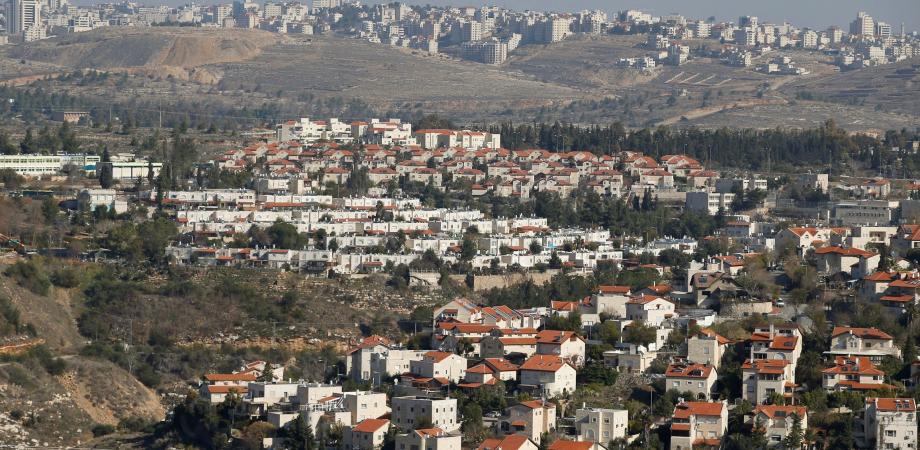The National Bureau for Land Defense and Settlement Resistance said that the Israeli government has contributed to building at least 14 settlement outposts without an official announcement since 2011.
The office added in its weekly report on settlement, today, Saturday, that the talk at the present time revolves around the legitimization of 130 settlement outposts established on Palestinians' lands in the West Bank, including the Jordan Valley, inhabited by about 10 thousand settlers, the vast majority of whom they call "the hills youth" who are active in terrorizing the Palestinians, carrying out crimes of "paying the price", attacking and destroying their agricultural crops and preventing them from accessing their lands.
The approval of the Knesset in the preliminary reading of the draft law on settling outposts in the West Bank was not a surprising event for the Palestinians, since such an approach was known and is part of the implementation of the "deal of the century", prepared by the Israeli government and adopted by the US administration headed by Trump.
The office pointed out that the draft law was submitted by Knesset member Bezalel Smotrich from the Yamina party, and 60 Knesset members voted alongside it, at a time when the various relevant government ministries were obligated to provide all settlement outposts with infrastructure services, including electricity, road networks, water, communications and transportation.
The office said: "It is known that the Israeli governments have financed the establishment of these settlement outposts, directly and indirectly, and through joint work with various settlement associations, such as Al Hillah 387 outpost, which was established by Harroei Haifari association, which aims to rehabilitate the "hillside youth", where the association receives fixed funding from the Israeli Ministry of Education, worth hundreds of thousands of shekels annually, in addition to the ministries of housing, agriculture, and settlement affairs."
The proposed law states that the Israeli government will give legal status and work to legalize outposts, according to a decision issued by the Israeli cabinet, government ministries must provide basic services to the settlers who inhabit these outposts.
The law proposal was approved by the Minister of Settlement Affairs, Tzachi Hanegbi, that the Israeli government is working on formulating a plan to legalize all outposts.
"The government decided to organize and settle all the outposts and the random settlement buildings that were built in the past twenty years," the interpretation of the law stated.
The Israeli government is not the only one who pledged to finance the establishment of outposts, as the settlement councils also formed sources of funding for the establishment of such outposts, and one of the government’s tools to impose facts on the ground, and demanded their legitimacy, which it had.
According to the sources of the National Office, the Gush Etzion Settlements Council spent large sums of money to buy a truck and the agricultural tools and build the Hafat Nahal Haletz site in different settlement.
In this context, settlers rebuilt a settlement room on Palestinians' lands in Al-Baqa'a area near Kiryat Arba settlement, which was built on citizens' lands east of Hebron.
They also built tents in Al-Jumah area in the northern Halhoul town, in preparation for building a settlement on the hills of the town, and they brought generators. Yossi Dagan, Chairman of the Settlements Council, called on the Israeli government to approve the continuation of settlement construction, especially a new settlement on the hills of Halhul.
This approach comes with the legalization of the outposts, with the approval of one of the largest settlement plans in Jerusalem, which was proposed by the Israeli municipality to establish 8,300 new settlement units.
The Israeli municipality submitted this plan to the "Planning and Building Committee", as the plan calls for building this large number of settlement units, modernizing the Talpiot industrial zone, and building a group of multi-use towers at a height of 30 floors.
The plan also includes administrative towers, technical and office functions in the Green Zone, extending from the lands of Beit Safafa, Al Malha, Baqa'a, and the new industrial zone "Talpiot" Al Walaja village.
The danger of this settlement scheme is that it extends from 2021 to 2040 and includes the construction of a group of public places such as parks, interior gardens, squares, streets, a market, and shaded streets with bike lanes, and seating and rest areas.
In Jerusalem, the Israeli municipality intends to build a new settlement project and change one of the most important tourist destinations in the city, represented by Jaffa Gate in the Old City, and this will completely change the place, to become a tourist complex and the establishment of an underground museum, the other side of the old town.
The municipality also plans to build a settlement neighborhood at the top of the Wadi al-Rababa neighborhood, as it prepared the necessary infrastructure for that in the area to turn it into a settlement, as happened with 11 settlements in the lands occupied in 1967, where Israel established the settlements of Givat Ze'ev, Gilo and Ma'alia. Adumim and Jabal Abu Ghneim in the lands occupied by the Israeli authorities.
Source : Safa




